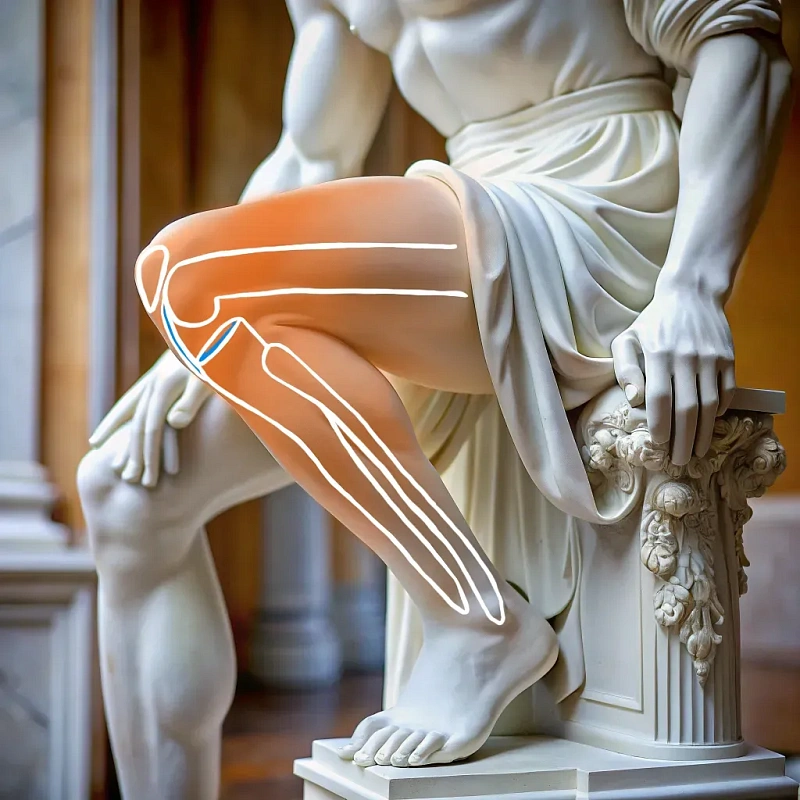Revision arthroplasty of a large joint
Replacement of a previously installed endoprosthesis due to the development of complications such as paraendoprosthesis infection, which is carried out to completely eliminate the infection and restore joint function.

Paraendoprosthetic infection is an inflammatory process that develops in the area of an installed endoprosthesis due to bacterial infection.
This condition causes pain, swelling, redness of the skin around the joint, a violation of its function, Infection can develop in the first weeks after surgery or several years after the implant is installed. If the infection is not treated in a timely manner, it can lead to destruction of the surrounding tissues, bones and the components of the prosthesis themselves, which causes joint instability and further complications. Conservative antibiotic treatment is rarely successful in cases of deep infectious pathology of the endoprosthesis.
A general blood and urine test. Blood type and Rh factor. Biochemical research. Coagulogram for the assessment of blood clotting. Radiography and MRI or CT to visualize the condition of bones and surrounding tissues (determined at the initial consultation). Examination for the presence of infectious diseases (HIV, hepatitis). Inoculation for antibiotic sensitivity for the choice of antibacterial therapy. ECG and fluorography. Ultrasound of the veins of the lower extremities. ECHO of KG and EGDS with a long history of the disease, with constant use of painkillers. Consultation with an anesthesiologist and therapist. An endocrinologist, if necessary.
There are two main approaches to performing revision arthroplasty: one-stage and two-stage revision. One-stage revision is used for early infections. During the operation, the infected endoprosthesis is removed, the surgeon performs a thorough rehabilitation of the joint, removing necrotic tissues and rinsing the cavity with antiseptic solutions. A new revision endoprosthesis is installed in place of the old implant. Two-stage revision is used for more severe or chronic infections. During the first operation, the infected endoprosthesis is removed and the joint is cleaned of the affected tissues. A temporary spacer is installed in place of the prosthesis, which helps to preserve the structure of the joint and provides a high local concentration of an antibiotic to fight infection. After 3-6 months, after a course of antibiotic therapy and in the absence of signs of infection, the spacer is replaced with a permanent revision endoprosthesis.
Surgical instruments. Revision endoprostheses. Antibiotic spacers.
After surgery, the patient is prescribed a course of antibacterial therapy to prevent recurrence of infection. Rehabilitation includes limiting physical activity in the early stages, after which physical therapy is prescribed to gradually restore mobility. Full recovery after revision arthroplasty may take several months.
Benefits
Complete elimination of infection
Joint rehabilitation and replacement of the prosthesis can eliminate the infection.
Restoration of joint function
After a successful revision, patients can regain joint mobility.
Preservation of anatomy
The use of spacers and revision prostheses helps to preserve the anatomical structure of the joint.
High probability of success
With a two-stage revision, the probability of successful infection treatment reaches 80%.
Frequently Asked Questions
How long does the recovery after revision arthroplasty last?
Is it possible to save the implant during the infectious process?
How high is the risk of infection recurrence?
Didn't find an answer to your question?
You can describe your problem in detail and ask a question to the doctor. He will answer you and help you find a solution
Врачи
Смотреть всех врачейOrthopedic Trauma Surgeon
Similar referral activities
Arthroscopy of the ankle joint
Ankle arthroscopy is a minimally invasive surgical procedure used to diagnose and treat various diseases and injuries of the ankle joint.
Arthroscopy of the knee joint
Knee arthroscopy is a minimally invasive surgical procedure for the diagnosis and treatment of injuries and diseases of the knee joint. It allows examining the joint for damage and eliminating the identified defects.
Arthroscopy of the elbow joint
Arthroscopy of the elbow joint is a minimally invasive surgical intervention that allows for accurate diagnosis and simultaneous treatment of joint injuries.
Arthrodesis of the joints of the fingers of the hand
The destruction of the joints of the fingers of the hand is accompanied by pronounced pain and impaired functions. Arthrodesis is a surgical intervention in which the affected joint is completely immobilized, which relieves pain and progression of inflammation.
Arthroscopic revision of the cystic joint
The condition of the wrist joints determines the functioning of the hand. Arthroscopic revision is a minimally invasive diagnostic procedure that assesses the condition of the joint tissues, which is necessary for planning subsequent treatment.
Arthroscopy of the shoulder joint
Arthroscopy of the shoulder joint is a minimally invasive surgical procedure designed to diagnose and treat various diseases and injuries of the shoulder joint.
